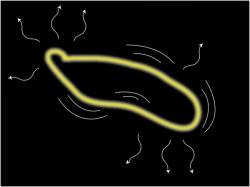 One of Einstein’s predictions for relativity is the concept of gravity waves; these are emitted whenever massive objects move. The more massive the object the stronger the gravity wave.
One of Einstein’s predictions for relativity is the concept of gravity waves; these are emitted whenever massive objects move. The more massive the object the stronger the gravity wave.
Experiments here on Earth are trying to detect these faint gravity waves, but they could be fine tuned to search for another theoretical cosmological mystery: cosmic superstrings. Theoretically speaking, these would be narrow tubes of energy left over from the beginning of the Universe. The first moments of inflation after the Big Bang would have stretched them out to enormous lengths through the Universe’s expansion.
University of Washington researcher Craig Hogan believes that these cosmic superstrings could still be out there, invisible to our regular instruments, but detectable by the gravity waves they emit as they flop around, losing energy.
A detector called the Laser Interferometer Gravitational-Wave Observatory is searching for the gravitational waves from events like the formation of black holes and colliding neutron stars – but it’s listening at higher frequencies. Hogan believes that LIGO could listen at lower frequencies, and might be able to detect these superstring gravity waves.
Original Source: UW News Release
